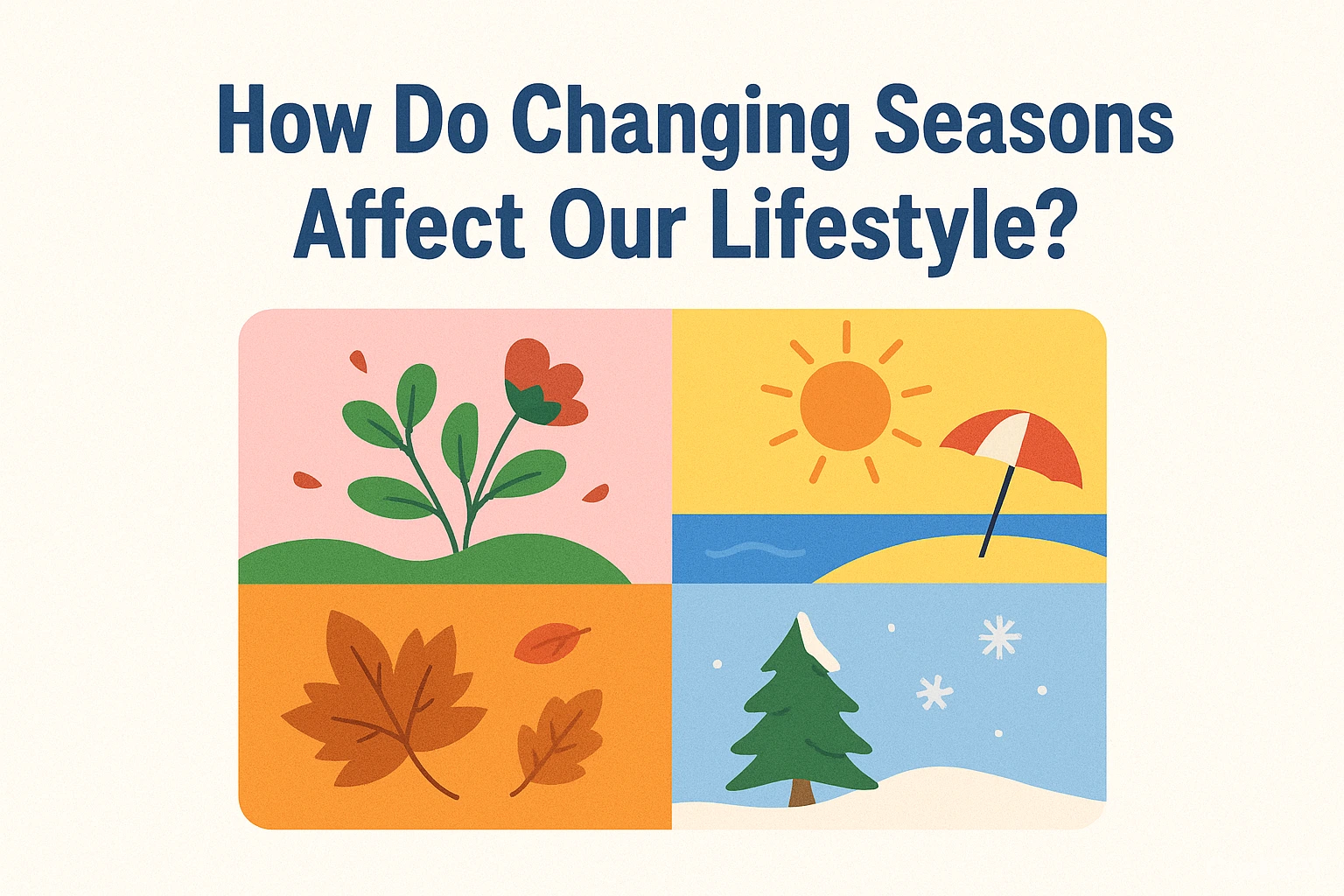Introduction
How do changing seasons affect our lifestyle in ways we often overlook? From the clothes we wear to the food we eat, every shift in weather brings adjustments to our routines. Warmer months often boost outdoor activities and productivity, while colder days may influence mood, fitness, and eating habits. These seasonal changes not only shape our physical health but also impact mental well-being and social life. At All Worldwide News, we explore how adapting to these transitions helps us maintain balance year-round.
The Connection Between Seasons and Lifestyle
How do changing seasons affect our lifestyle? The answer lies in the subtle ways weather shapes our habits, health, and behavior. Warmer months usually inspire outdoor activities, lighter meals, and higher social interaction, while colder seasons bring comfort foods, layered clothing, and a slower pace of life. These seasonal lifestyle changes highlight the strong connection between our environment and human behavior, showing that even small shifts in temperature or daylight can influence our daily choices.
How Seasonal Changes Impact Daily Routines
Every season modifies routines like sleep, diet, and physical activity. Summer often means fresh fruits, longer days, and more energy for fitness, while winter encourages indoor workouts, hearty meals, and earlier rest. Dressing according to seasons also plays a role in comfort and confidence.
Weather Effects on Mood and Productivity
Weather directly affects mental well-being. Bright, sunny days boost motivation and focus, whereas gloomy or cold days can lower energy and reduce productivity. This connection reveals how seasonal changes and human behavior remain deeply intertwined.
Seasonal Health and Fitness Adjustments
How do changing seasons affect our lifestyle when it comes to health and fitness? Each season carries unique challenges and opportunities. Summer often encourages outdoor activities, hydration, and light diets, while winter demands stronger immunity, indoor workouts, and nutrient-rich meals. Spring and autumn act as transitional phases, requiring balance between energy and recovery. By adapting lifestyle to weather changes, we can protect both physical health and mental stability throughout the year.
Exercise and Fitness Across Different Seasons
Fitness routines shift with seasonal changes. In warmer months, people prefer outdoor exercises like running, cycling, or swimming. Cold weather, however, pushes many toward yoga, strength training, or home-based workouts. Seasonal changes and human behavior are directly visible in the way exercise preferences evolve across climates.
Seasonal Food Habits and Nutrition
Food choices also change with weather. Seasonal fruits and vegetables not only support health but also improve immunity. Eating fresh produce aligns with body needs, whether it’s hydrating foods in summer or warming meals in winter.
| Season | Common Foods | Benefits |
|---|---|---|
| Summer | Watermelon, cucumber, berries | Hydration, cooling effect, vitamins |
| Winter | Nuts, root vegetables, citrus fruits | Boost immunity, warmth, energy |
| Spring | Leafy greens, peas, strawberries | Detoxification, fiber, antioxidants |
| Autumn | Apples, pumpkins, squash | Digestive health, vitamins, seasonal balance |
Dressing and Fashion in Different Seasons
How do changing seasons affect our lifestyle when it comes to clothing? Our wardrobe choices are directly influenced by weather conditions, comfort needs, and social expectations. Dressing according to seasons is not just about style, it ensures health, confidence, and adaptability. While summer demands breathable fabrics and lighter shades to combat heat, winter calls for layering, woolen wear, and warmer tones that protect against the cold. Spring and autumn bring transitional outfits where flexibility is key, allowing us to adapt to sudden shifts in temperature.
Clothing Choices for Comfort and Style
Seasonal lifestyle changes highlight the importance of blending fashion with comfort. Light cottons and linens in summer keep the body cool, while fleece and jackets in winter provide insulation. Footwear also shifts, from sandals and sneakers in warmer months to boots and closed shoes in colder weather. Choosing fabrics and styles according to the season helps maintain both comfort and personal expression.
Seasonal Fashion Trends
Fashion trends evolve with seasons, reflecting cultural events, festivals, and social gatherings. Bright colors and floral prints dominate spring, while autumn embraces earthy tones. Designers often create collections inspired by seasonal transitions, showing how adapting lifestyle to weather changes also shapes modern fashion choices.
Psychological and Social Effects of Changing Seasons
How do changing seasons affect our lifestyle beyond physical habits? The answer often lies in our psychological state and social interactions. Seasonal changes and human behavior are strongly linked, as weather influences mood, motivation, and even community life. Bright, sunny days often inspire positivity and energy, while prolonged cold or dark months can trigger fatigue and stress. These natural cycles affect not just individuals but also how societies plan events, celebrations, and gatherings throughout the year.
Seasonal Affective Disorder (SAD) and Mental Health
A clear example of seasonal mental health changes is Seasonal Affective Disorder (SAD). This condition commonly arises in colder months when reduced sunlight lowers serotonin levels, affecting mood and productivity. Exercise, exposure to natural light, and balanced diets are helpful strategies for adapting lifestyle to weather changes and reducing emotional stress during such periods.
How Festivals and Social Activities Vary by Season
Social life also shifts with weather patterns. Summer often brings outdoor festivals, weddings, and community events, while winter traditions focus on indoor celebrations and family gatherings. Spring and autumn host transitional festivals, balancing cultural rituals with seasonal transitions. These patterns reveal how deeply seasonal lifestyle changes shape both personal well-being and collective social behavior.
Seasonal Impact on Work and Productivity
How do changing seasons affect our lifestyle in professional settings? Workplace performance is often influenced by weather patterns and environmental changes. Research shows that bright, sunny days can boost energy, creativity, and focus, while colder, darker months may reduce motivation and concentration. This link clearly demonstrates how weather affects mood and productivity, shaping both individual efficiency and overall team performance. Companies and employees alike need to adapt their routines to minimize these seasonal challenges.
Adapting lifestyle to weather changes can help maintain consistency at work. Simple adjustments in routine, nutrition, and environment allow employees to stay balanced and productive regardless of the season.
Tips for staying productive in each season:
- Summer: Stay hydrated, take short breaks outdoors, and use lighter meals to maintain energy.
- Winter: Ensure proper indoor lighting, add short movement breaks, and eat nutrient-rich foods for warmth and focus.
- Spring: Use the natural energy boost for new projects and maintain allergy care for better concentration.
- Autumn: Adjust to shorter days with structured routines and embrace seasonal foods to sustain energy.
Seasonal Travel and Leisure Activities
How do changing seasons affect our lifestyle when it comes to recreation and travel? Seasonal lifestyle changes play a big role in how people plan holidays, sports, and leisure activities. Warm weather often invites outdoor adventures such as hiking, swimming, and camping, while colder months encourage indoor gatherings, winter sports, or cozy family trips. The choice of activities reflects how individuals and families are constantly adapting lifestyle to seasonal changes.
Travel destinations also vary according to climate. Tourism peaks in summer as travelers head to beaches, mountains, and cultural festivals. In contrast, winter sees a surge in visitors to ski resorts, indoor retreats, and holiday-themed destinations. These seasonal patterns highlight how tourism adapts to both weather conditions and human behavior.
Sports and leisure activities also follow this rhythm. Outdoor games dominate in spring and summer, while autumn and winter shift focus to fitness centers, indoor arenas, and seasonal hobbies. This balance ensures that recreation stays meaningful and enjoyable throughout the year, no matter the weather.
Adapting Lifestyle to Seasonal Changes
Seasonal lifestyle changes remind us that flexibility is key to maintaining balance. By adapting lifestyle to seasonal changes, people can protect their physical health, mental well-being, and productivity. Small adjustments in diet, clothing, and daily routines can make transitions between hot and cold months much smoother.
Healthy Habits for Summer, Winter, Spring, and Autumn
In summer, hydration, outdoor fitness, and fresh fruits are essential. Winter demands nutrient-rich foods, indoor exercises, and light therapy to counter reduced sunlight. Spring encourages detoxification with leafy greens and outdoor activities, while autumn calls for structured routines, warmer meals, and immune-boosting habits. These practices show how seasonal changes and human behavior are naturally interconnected.
Balancing Work, Health, and Social Life with Seasonal Shifts
Maintaining balance requires planning. Bright summer days can fuel creativity at work, while winter months need structured schedules to stay motivated. Family gatherings, festivals, and cultural events are also tied to seasonal shifts, influencing how we divide time between social and professional life. Interestingly, adapting our approach to work is much like exploring how many jobs are available in technology in 2025, both require preparation for changing environments and future demands.
FAQs
Why do seasons have such a strong impact on human life?
Because they influence daylight, temperature, food availability, and social activities, which directly affect our health, mood, and daily routines.
How can we stay healthy during extreme weather changes?
By adjusting diet, staying hydrated, dressing appropriately, and following safe exercise and sleep patterns.
Does weather really affect mood and productivity?
Yes, sunlight boosts energy and focus, while gloomy or extreme weather can lower motivation and mood.
Which foods are best for different seasons?
Fresh fruits in summer, warm soups in winter, leafy greens in spring, and root vegetables in autumn help maintain balance.
How to adjust exercise routines according to weather?
Choose outdoor workouts in mild weather, and switch to indoor or low-impact activities during extreme heat or cold.
Conclusion
Changing seasons affect our lifestyle in many ways, from health and fitness to mood, productivity, travel, and even fashion. Each season brings unique challenges and opportunities that shape our daily routines and social activities. By adapting positively, through healthy habits, balanced work-life adjustments, and mindful choices, we can maintain stability in health, productivity, and overall well-being. Embracing seasonal shifts not only helps us stay prepared but also allows us to enjoy the beauty and variety each season brings.












